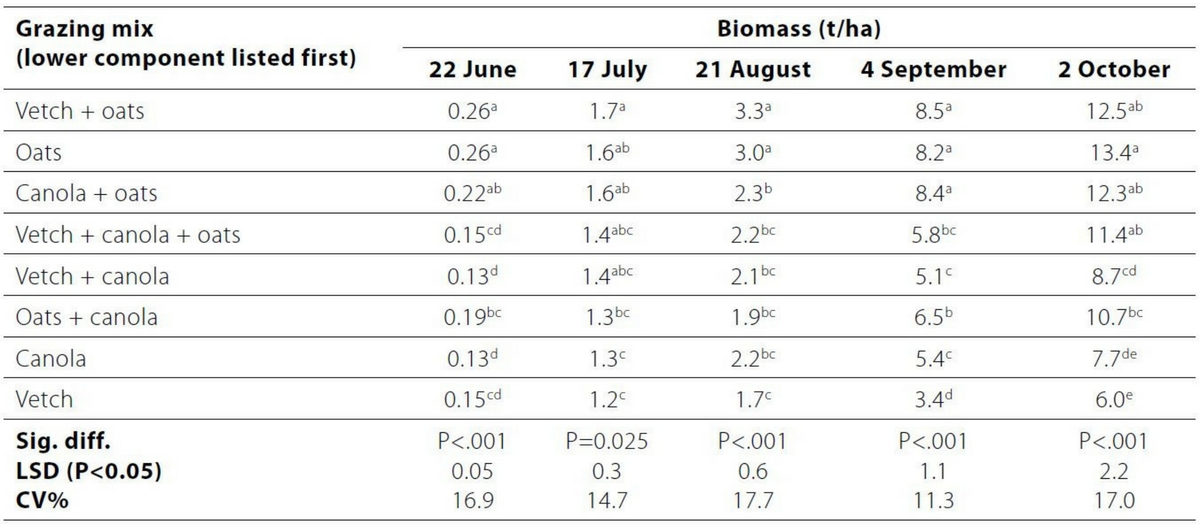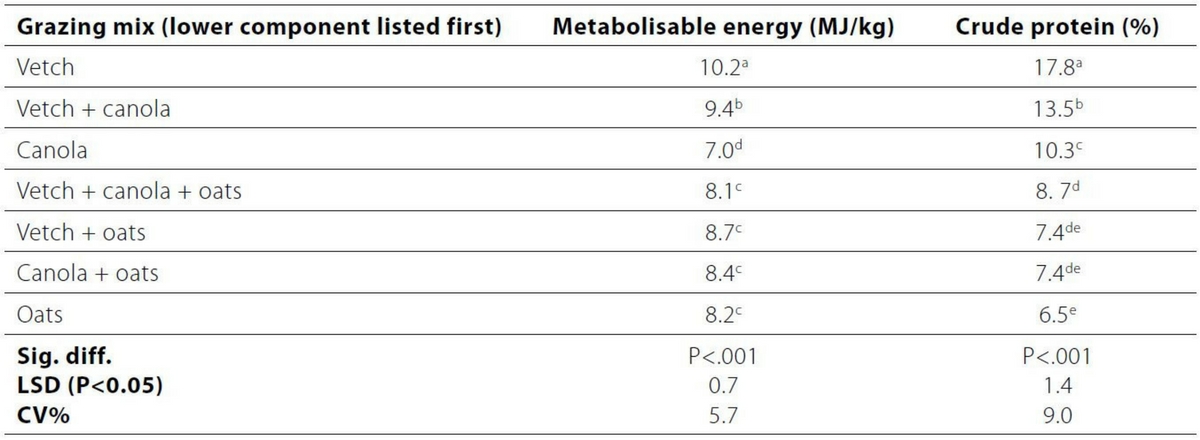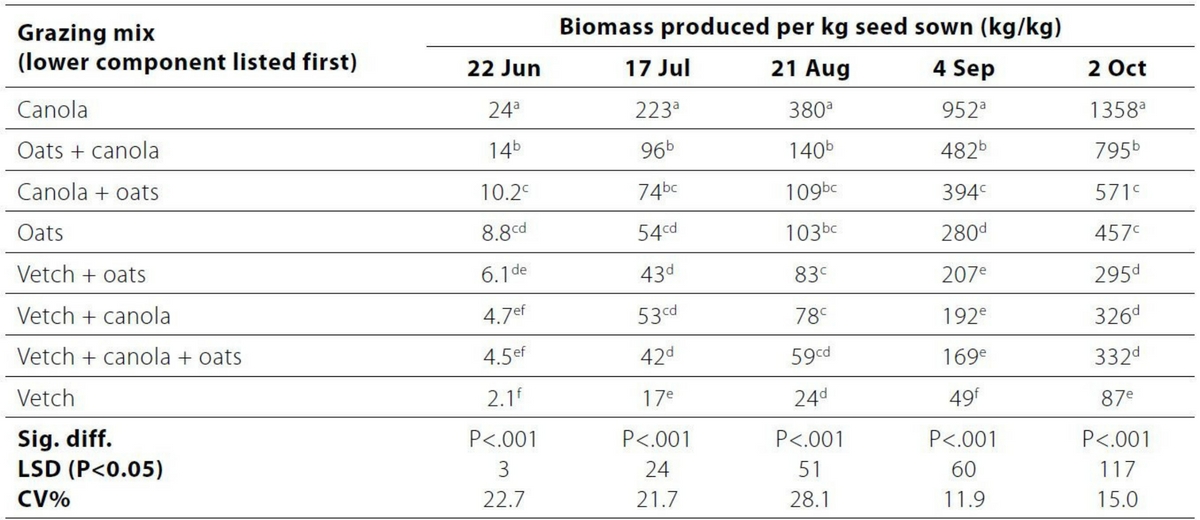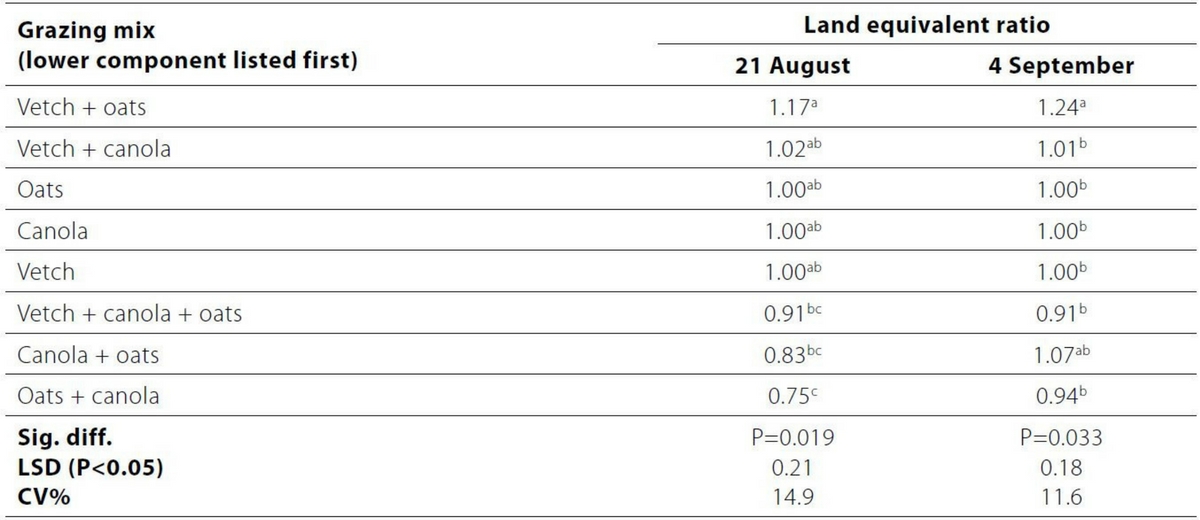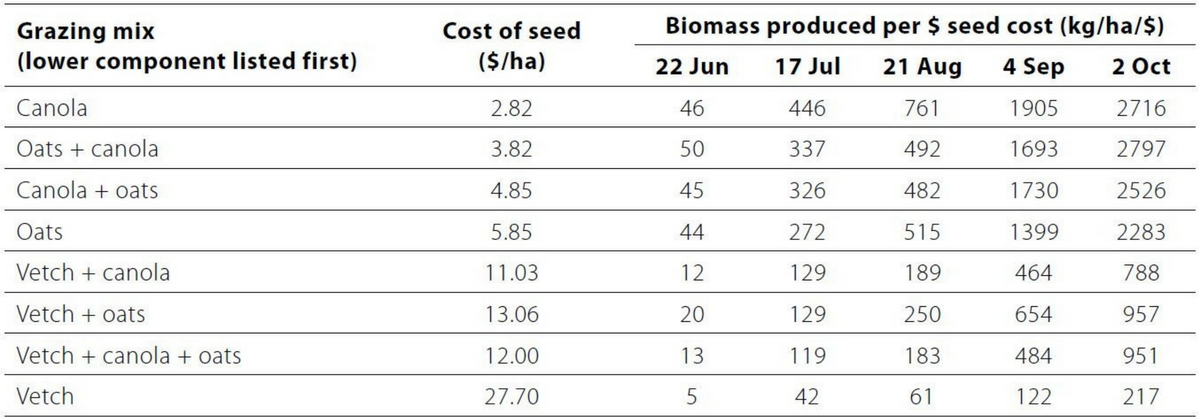Take home messages
- Adding canola to vetch pasture increases biomass production without affecting feed quality, and substantially reduces seed costs and storage requirements.
- Oats in monoculture produce the greatest amount and best quality feed early in the season.
- Whole-farm forage production over the growing season could be optimised by growing both a of monoculture oats for early grazing, and vetch + canola for later grazing ensuring robust grass weed control.
Background
Annual fodder crops such as vetch and oats are commonly grown in the Wimmera and Mallee to boost winter and spring livestock feed. Both crop types have their benefits to the system with the belief that oats provide early vigour and high quantities of biomass throughout the season, and vetch a higher quality feed while building soil nitrogen for future non legume grain crops.
A major drawback of growing these forages, however, is the pressure that is places on retaining and storing seed for the following season’s crop. This is especially true in dry seasons where it can be difficult to harvest sufficient vetch and oats for the following year’s crop. Additionally, storage may prove costly using space that could otherwise be utilised to store higher value grains for marketing throughout the year.
Canola has the potential to be used as an alternative forage option to oats or vetch, placing less pressure on seed storage space given the lower volume requirements to sow canola. The amount and quality of feed that canola can produce is still relatively unknown in the Wimmera and Mallee region.
In this trial, canola was grown as a mono-culture and also in combination with vetch and oats to see what quality and quantity of feed could be produced by these crop combinations. Combining the species could provide an opportunity to lower the pressure placed on seed storage for vetch and oats while still maintaining the quality and quantity of feed produced.
Aim
To determine which crop species, either single or combined will produce the greatest quality and quantity of feed throughout the growing season.
Paddock details
| Location: | Curyo |
| Crop year rainfall: | 297mm |
| GSR (Apr-Oct): | 215mm |
| Soil type: | Sandy clay loam |
| Paddock history: | 2016 fallow, cultivated |
Trial details
| Crop type/s: | Winteroo oats, Morava vetch, Bonito canola |
| Treatments: | Table 1. |
| Target plant density: | Table 1. |
| Seeding equipment: | Knife points, press wheels, 30cm row spacing |
| Sowing date: | 4 May 2017 |
| Replicates: | Four |
Trial inputs
| Fertiliser: | Granulock Supreme Z + Impact® @ 55kg/ha at sowing | |
| Herbicide: | October 2 | (Desiccation) Glyphosate @ 2.5L + Sharpen @ 34g/ha |
| October 7 | (Desiccation) Gramoxone @ 2.5L + Sharpen @ 34g/ha | |
| Insecticide: | May 4 | Lorsban® @ 1.2L/ha + Talstar® @ 0.5l/ha |
| August 30 | Lorsban® 0.7L/ha + Alpha cypermethrin @ 0.1L/ha | |
| Seed treatment: | Vetch – P-pickle T, oats – Vibrance® and Gaucho®, Canola – N/A | |
Table 1. List of plant species and plant densities used in the trial.
Method
A replicated field trial was sown at Curyo using a complete randomised block design. Plots were sown as either a single, double or triple species mixture. Crops were sown according to the target plant density outlined in Table 1. Throughout the growing season assessments included establishment counts after the crop had emerged, and five in-crop biomass cuts which were taken on 22 June, 17 July, 21 August, 4 September and 2 October. Biomass cuts involved separation of crop types to be individually dried and weighed for their biomass yield/ha. Biomass cuts from 17 July and 2 October were used for a basic feed test to get protein and energy for the crop types. The 17 July represented the start of grazing and 2 October represents a potential hay cut in the absence of grazing.
Results and interpretation
Biomass yields
The biomass yields presented in Table 2 show that when oats dominate the plant number within the crop mixture these mixtures ranked highest. This is consistent with oats early vigour and rapid biomass accumulation. Vetch produced the lowest biomass and canola was between these two other crop types. It should be pointed out that this site had very high levels of starting soil N following a mechanical long fallow, which may limit differences observed between vetch and the other species.
Table 2. Biomass yields. Cuts from 17 July are highlighted to represent initial grazing and when the feed tests were completed.
Feed quality
17 July
Early feed tests show that oats had higher energy content compared other species. Combining the oats higher biomass yield and energy translates to a greater amount of energy available per hectare in oat mixtures than other mixes at this time. A higher amount of energy per hectare allows for higher carrying capacity of livestock. All species had very high protein contents, reflecting the high levels of mineralised N at the site.
Table 3. Feed test results from the 17 July biomass cut. Energy is presented on a per hectare basis incorporating biomass yields and energy (ME) per kg of dry matter. Protein is presented per kg of dry matter.
October 2
The October biomass cuts were taken to represent a hay cut, the feed tests from these cuts show that vetch had the highest protein and energy contents. Canola was higher for protein but lowest in energy, however when it was combined with vetch it became a higher value feed.
Table 4. Feed test results from 2 October cut with both energy and protein presented per kg of dry matter.
Seed biomass production
Storing and retaining seed for forage production can be costly when the storage space could be used for storing and marketing higher value grains (eg. lentils and chickpeas) after harvest. In Table 5, the amount of biomass produced per kg of seed sown was calculated to give an indication of how efficient each seed was at producing biomass. Canola exceeded all other seed types in producing a high amount of biomass per kg of seed sown across all biomass cuts. These results combined with the relatively good feed tests show some potential for canola to be a viable option where seed storage space is at a premium.
Table 5. Biomass produced per kg of seed sown at all harvest times in the trial.
Land Equivalent Ratio (LER)
Intercropping two or more species can result in greater yields than if the same species were grown separately. To measure this effect, LER is calculated to determine if an intercropping combination is better than individually cropping each of the species. A value greater than one suggests that an intercrop would yield higher than monoculture and a value of less than 1 would suggest that the species would yield better if grown separately. There was a positive effect on LER when vetch and oats were grown together but not for any other combinations (Table 6). However, this effect is small and only significantly different in the 4 September cut. Oats and canola appeared to be antagonistic to each other, which suggests they may not grow as well in a mixture as they do in a monoculture.
Table 6. Land equivalent ratio of the grazing mixtures. Only presented for 21 August and 4 September as they were the only cuts that were significantly different to each other.
Commercial practice and on-farm profitability
Canola showed potential to reduce the cost and storage requirements of forage seed, particularly when intercropped with vetch. In combination with vetch, we demonstrated significantly greater dry matter production in comparison to vetch alone, and had an LER close to 1 indicating it was not opposed to vetch. This mix also delivered the second-best feed quality after vetch at the 2 October cut (hay cut), with 2.7t/ha more biomass than vetch alone, and has much lower seed costs in comparison to growing vetch alone (Table 7).
Another advantage of this mix is that it allows for greater grass weed and root disease control during the pasture phase in comparison to mixtures with oats, which will benefit subsequent crops. Canola and oats were opposed to each other in the LER but could still provide a good forage option given the amount of biomass produced and feed test results in the early biomass cut.
Oats in monoculture had high biomass production and metabolisable energy in July, and in any mixture increased biomass production throughout the season. However, the feed quality of oats deteriorated by the end of the season to be one of the lower quality fodder crops in the trial. There was no clear benefit of adding vetch to oats in terms of biomass production or feed quality at any time, and it significantly reduced the amount of forage grown per kg of seed by comparison to oats. The advantage of this mixture was in increased LER, which implies that if growers wish to grow both oats and vetch for forage, they will produce more biomass if growing them in mixture rather than monoculture.
Optimal forage production throughout the year could be achieved by growing some species in mixture and some in monoculture in different paddocks. For instance, monoculture oats could be grown in one set of pasture paddocks to provide rapid early forage and terminated early once feed quality declines to prevent seed-set of grass weeds. Vetch + canola could be grown in another set to provide high quality feed later in the season, and with good in-crop grass weed control could be terminated later or not at all to allow grazing later into spring.
Table 7. Biomass produced per dollar of seed in this trial. Based on the average biomass yields per ha for each grazing mixture at each cut. Prices are based on using $500/t for canola, $200/t for oats and $400/t for vetch.
Acknowledgements
This project was funded by La Trobe University and supported by Agriculture Victoria, through the ‘Improving practices and adoption through strengthening D & E Capability and delivery in the southern region’ (RRA) program – DAV00143 GRDC DEDJTR Bilateral Research Agreement.

